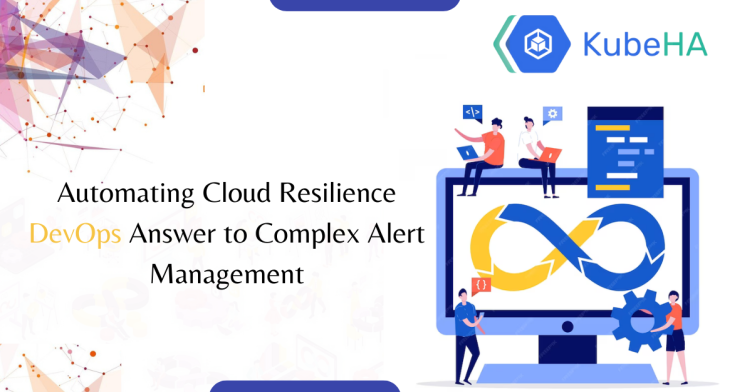
The importance of cloud resilience cannot be overstated. Organizations rely on cloud services to ensure high availability, scalability, and performance of their applications. However, this dependence on the cloud also introduces new challenges, especially when it comes to managing and responding to alerts.
Key Strategies for Automating Cloud Resilience
1. Smart Alert Filtering
Automated systems can be trained to differentiate between critical alerts and routine notifications. By setting up intelligent filters, DevOps teams can ensure that only the most crucial notifications are escalated.
2. Predictive Scaling
Automation tools can monitor resource utilization trends and dynamically adjust capacity based on predicted demand. This proactive approach ensures that your cloud environment is always prepared for sudden spikes in traffic.
3. Self-Healing Systems
Automated scripts can be designed to respond to specific alerts by executing predefined actions. For example, in the event of a server failure, an automated system can initiate a failover to a standby instance.
4. Intelligent Incident Escalation
Automation can handle incident triage, categorizing and escalating issues based on severity and impact. This ensures that the right team members are notified promptly, streamlining incident response.
Tools of the Trade
Several powerful DevOps tools are available to facilitate cloud resilience automation. Platforms like AWS CloudWatch, Google Cloud Operations Suite, and Azure Monitor offer comprehensive alerting and automation capabilities.
The Benefits of Automated Cloud Resilience
Improved Responsiveness: Automation ensures that critical alerts are addressed promptly, minimizing downtime and service disruptions.
Enhanced Efficiency: DevOps automation reduces the burden on human operators, allowing them to focus on higher-level tasks.
Cost Optimization: Predictive scaling and resource optimization lead to reduced cloud infrastructure costs.
Consistency and Reliability: Automation eliminates human error, ensuring that responses to alerts are consistently accurate.
Getting Started with Cloud Resilience Automation
Implementing automated cloud resilience requires careful planning and a deep understanding of your specific environment. Start by conducting a thorough audit of your current alerting system and identifying areas where automation can add value.
The Evolution of Alert Management:
Traditionally, managing alerts in a cloud environment has been a manual and often overwhelming task. With the increasing complexity of modern cloud architectures, this approach is simply no longer sustainable. DevOps introduces a paradigm shift by incorporating automation into the alert management process.
The Challenge of Alert Management
With the adoption of cloud technologies, the volume and complexity of alerts have increased significantly. Teams are inundated with notifications from various cloud services, making it challenging to differentiate between critical issues that require immediate attention and less urgent ones. The result? Alert fatigue, delayed incident response, and potential service disruptions.
Enter DevOps and Automation
DevOps, a collaborative approach that combines development and operations, has emerged as a solution to these challenges. DevOps teams aim to streamline development, deployment, and operations by breaking down silos and automating repetitive tasks. When it comes to cloud resilience, DevOps plays a pivotal role by automating alert management and incident response.
Benefits of Automating Alert Management:
Faster Incident Resolution: Automation enables the rapid identification and response to critical incidents. Alerts can trigger automated actions, reducing the time it takes to mitigate issues.
Improved Accuracy: Human errors in manual alert handling can be costly. Automation ensures consistent and accurate responses to alerts, reducing the risk of misconfigurations or oversight.
Reduced Alert Fatigue: By filtering and prioritizing alerts, automation helps teams focus on critical issues, reducing alert fatigue and improving overall team morale.
Enhanced Scalability: As your infrastructure grows, so does the volume of alerts. Automation scales effortlessly, ensuring that your alert management system can handle increased demands.
Key Steps in Automating Alert Management:
Alert Routing and Prioritization: Implement rules and filters to categorize alerts based on severity, source, and impact. This helps ensure that critical alerts are addressed promptly.
Automated Incident Response: Create playbooks or workflows that define how to respond to specific alerts. Actions can include scaling resources, rolling back changes, or notifying the right team members.
Integration with Monitoring Tools: Integrate your alert management system with your monitoring tools and cloud services to gather real-time data and automate responses based on predefined criteria.
Continuous Improvement: Regularly review and refine your alert management automation to adapt to changing infrastructure and evolving threats.
Choosing the Right Tools
Selecting the right tools is crucial for successful alert management automation. There are several DevOps and alert management platforms available, such as Prometheus, Grafana, and PagerDuty. Evaluate your organization’s specific needs and choose tools that align with your goals.
Automating cloud resilience through DevOps is a game-changer in the modern digital landscape. It enables organizations to proactively manage alerts, respond to incidents swiftly, and ensure the highest level of availability for their applications and services. By harnessing the power of automation, DevOps is the answer to complex alert management, helping teams stay resilient in the face of challenges. Follow KubeHA Linkedin Page KubeHA